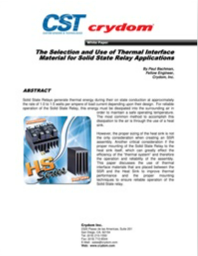The Selection and Use of Thermal Interface Material for Solid State Relay Applications Material for Solid State Relay Applications
Solid State Relays generate thermal energy during their on state conduction at approximately the rate of 1.0 to 1.5 watts per ampere of load current depending upon their design.
For reliable operation of the Solid State Relay, this energy must be dissipated into the surrounding air in order to maintain a safe operating temperature. The most common method to accomplish this dissipation to the air is through the use of a heat sink.
Download this whitepaper to find out more.
Read More
By submitting this form you agree to Sensata Technologies - Crydom contacting you with marketing-related emails or by telephone. You may unsubscribe at any time. Sensata Technologies - Crydom web sites and communications are subject to their Privacy Notice.
By requesting this resource you agree to our terms of use. All data is protected by our Privacy Notice. If you have any further questions please email dataprotection@techpublishhub.com


More resources from Sensata Technologies - Crydom

Crydom RHP Series 3 Phase Hybrid Solid State Contactor
Solid State Relays and Contactors (SSRs) have been available in one form or the other for over 40 years. Traditional Electromechanical Relays and C...

The Selection and Use of Thermal Interface Material for Solid State Relay Applications Material for Solid State Relay Applications
Solid State Relays generate thermal energy during their on state conduction at approximately the rate of 1.0 to 1.5 watts per ampere of load curren...

The Effect of Forced Air Cooling on Heat Sink Thermal Ratings
A Heat Sink's thermal rating can be effectively improved by increasing air flow over its exposed surface area.
Closed extrusion profiles or s...
